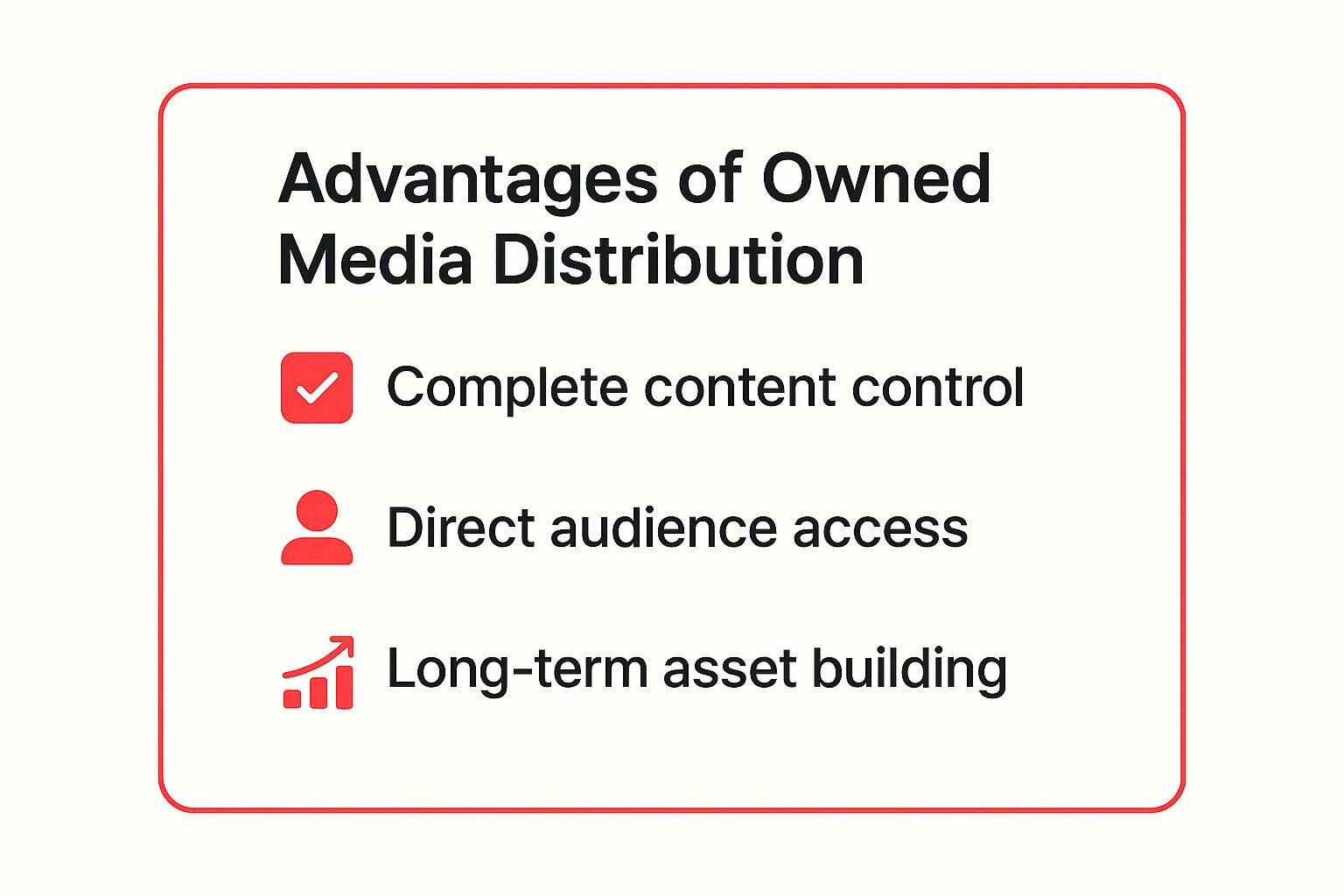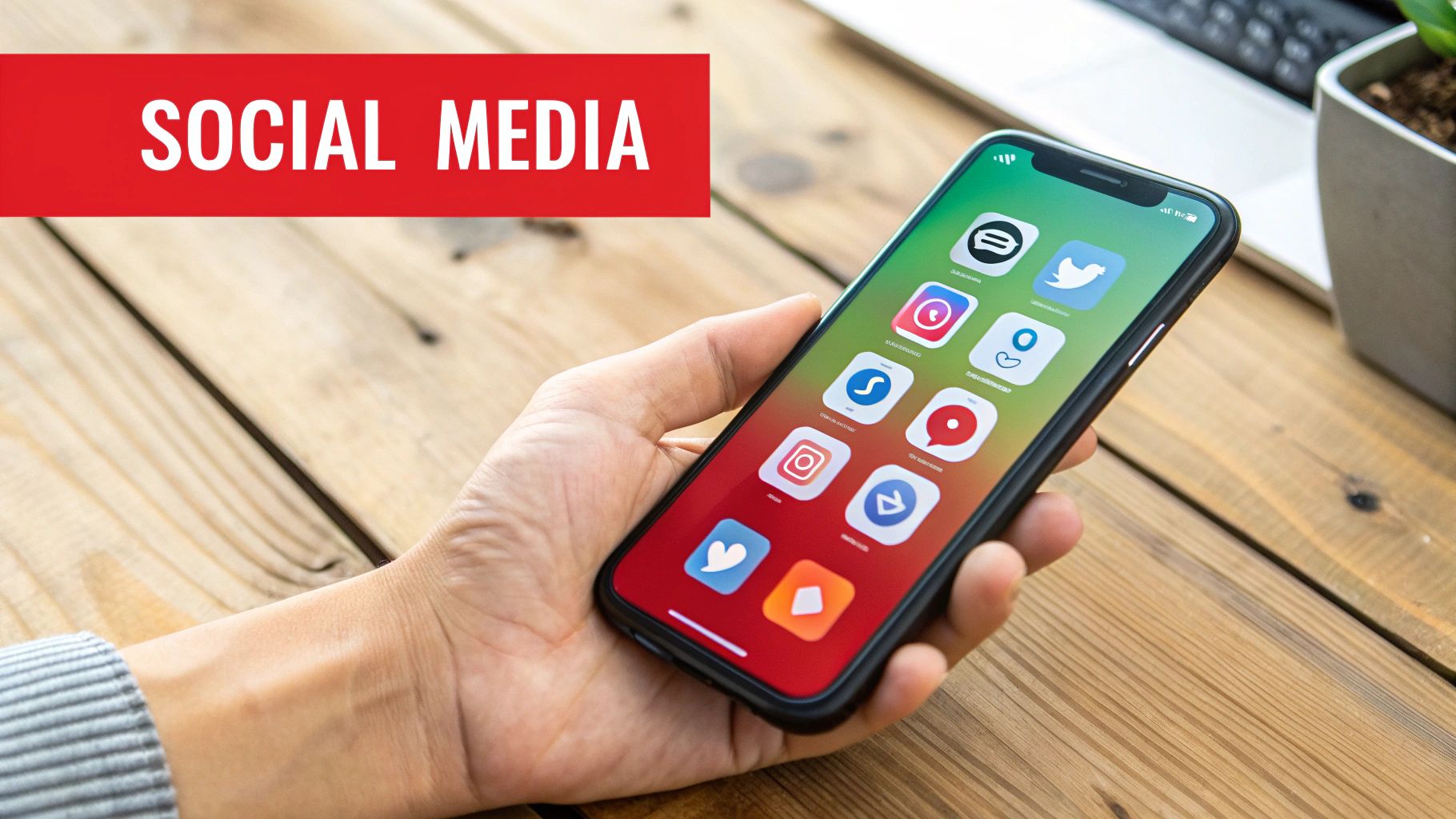Creating amazing content is only half the battle. Without a solid plan to get it in front of the right people, even the best work gathers dust. The challenge isn't just making noise; it's making your voice heard above the digital chaos. This is where mastering content distribution strategies becomes a game-changer. It's the critical link between creating value and capturing attention, turning your efforts into measurable results.
Forget the "if you build it, they will come" mindset. A proactive distribution plan ensures your content connects with your target audience, from faceless creators to established brands. For a comprehensive overview of how other organizations are approaching this challenge, explore these Top Content Distribution Strategies for Churches, which offer unique insights applicable across various niches.
In this guide, we'll break down 10 proven strategies across owned, earned, and paid media. We'll provide actionable steps and real-world examples to help you build a powerful distribution engine that drives traffic, engages audiences, and achieves your business goals. Let's move from simply publishing content to strategically distributing it for maximum impact.
1. Owned Media Distribution
Owned media distribution is the cornerstone of many successful content distribution strategies. It involves publishing content on platforms you fully own and control, such as your website, blog, email newsletters, and mobile apps. Unlike other methods, this approach gives you complete authority over your messaging, design, and user experience without being subject to third-party algorithms or fees.
This strategy is fundamental because it builds a direct line of communication with your audience, creating a stable, long-term asset for your brand. Think of how HubSpot's blog has become a go-to resource in marketing, or how Buffer uses its blog to attract and educate new customers. These companies have built digital properties that consistently generate traffic, leads, and trust.
How to Implement This Strategy
To get started with owned media, focus on creating a central content hub, typically a blog or resource center on your website.
- Invest in SEO: Optimize every piece of content to attract organic search traffic. This turns your website into a magnet for your target audience.
- Build an Email List: Use pop-ups, content upgrades, and clear calls-to-action to convert website visitors into email subscribers. An email list is a powerful, direct channel for content promotion.
- Create Cornerstone Content: Develop comprehensive, high-value guides or articles that solve major problems for your audience. These pieces attract links and sustained traffic over time.
The following graphic summarizes the primary advantages of focusing on your owned channels.

These three benefits highlight why owned media is not just a distribution channel but a strategic investment in your brand's future stability and growth.
2. Social Media Distribution
Social media distribution is one of the most dynamic content distribution strategies, leveraging platforms like Instagram, TikTok, LinkedIn, and X (formerly Twitter) to connect with audiences where they actively spend their time. This approach involves sharing content tailored to each platform’s unique format and user base, harnessing algorithms and engagement features to maximize reach and visibility.

Unlike owned media, social platforms offer built-in amplification mechanisms, allowing content to go viral and reach new segments of your target market organically. For example, Duolingo’s quirky, meme-focused TikTok account became a viral sensation, while Gymshark built its fitness apparel empire by mastering Instagram influencer collaborations. These brands meet their audience on their preferred channels with native, engaging content.
How to Implement This Strategy
A successful social media strategy requires adapting your content to fit the culture and technical specifications of each platform.
- Tailor Content for Each Platform: Don't just cross-post. Repurpose your core message into different formats, a high-quality image for Instagram, a professional article for LinkedIn, a short-form video for TikTok, and a witty comment for X.
- Engage Authentically: Social media is a two-way street. Respond to comments, participate in relevant conversations, and build a genuine community around your brand. Engagement is a key signal to platform algorithms.
- Use the 80/20 Rule: Dedicate 80% of your content to providing value, entertainment, or education, and only 20% to direct promotion. This builds trust and keeps your audience engaged without feeling constantly sold to.
3. Email Marketing Distribution
Email marketing is one of the most powerful content distribution strategies available, offering a direct and personal line to your audience's inbox. This method involves sending your content-newsletters, updates, and promotions-to a list of subscribers who have explicitly opted in. It's a permission-based channel that consistently delivers one of the highest ROIs in digital marketing because you're communicating with people who already want to hear from you.

Unlike social media, you are not subject to unpredictable algorithms. Media companies like Morning Brew and TheSkimm built their entire empires on an email-first strategy, proving its power to foster loyalty and drive engagement. By delivering value directly to the inbox, you build a relationship that nurtures leads and retains customers over the long term.
How to Implement This Strategy
To succeed with email, your focus must be on providing consistent value and respecting your audience's attention.
- Build Your List Organically: Offer valuable lead magnets like ebooks, checklists, or exclusive videos to encourage sign-ups. Never buy a list; an engaged audience is built on trust.
- Segment Your Audience: Group subscribers based on their interests, behavior, or purchase history. This allows you to send highly relevant, personalized content that resonates much more effectively.
- Write Compelling Subject Lines: Your subject line is your first impression. Keep it clear, intriguing, and ideally between 40-50 characters to avoid being cut off on mobile devices.
- Maintain a Consistent Schedule: Whether daily, weekly, or monthly, a predictable sending schedule helps build a habit with your readers and keeps your brand top-of-mind.
4. Content Syndication
Content syndication is a powerful method for amplifying your reach by republishing your original content on third-party websites. This strategy allows you to tap into the established audiences of larger platforms, placing your work in front of readers who might otherwise never discover your brand. It's one of the most effective content distribution strategies for expanding visibility without creating new assets from scratch.
This approach works by leveraging the authority and traffic of sites like Medium, LinkedIn Articles, or industry-specific publications like Business Insider. For example, a startup founder could syndicate a blog post about leadership on Entrepreneur, gaining instant credibility and referral traffic. When done correctly with proper attribution, syndication boosts your brand's authority and drives new users back to your owned media channels.
How to Implement This Strategy
To succeed with content syndication, focus on strategic partnerships and technical best practices to protect your SEO.
- Select High-Performing Content: Don't syndicate everything. Choose your best-performing articles that have already proven to resonate with an audience.
- Prioritize SEO Safeguards: Wait at least a week after initial publication for Google to index your original article. Always ensure the syndication partner uses a canonical tag pointing back to your original URL to avoid duplicate content penalties.
- Build Relationships: Identify relevant publications in your niche and connect with their editors. A good relationship can lead to consistent syndication opportunities.
- Customize for the Platform: While the core content remains the same, slightly tweak the headline or introduction to better fit the new platform’s audience and style.
5. Influencer and Partnership Distribution
Influencer and partnership distribution taps into the trust and reach of established individuals or brands to amplify your content. This strategy involves collaborating with key figures or complementary companies who promote your content to their dedicated audiences. Unlike advertising, this method leverages the authentic connection partners have with their followers, making the endorsement more powerful.
This approach is highly effective because it provides a shortcut to a relevant, engaged audience. A prime example is Gymshark, which built its billion-dollar brand by partnering with fitness influencers who genuinely used and loved their products. Similarly, Dropbox's early referral program turned its user base into distribution partners, rewarding them for sharing the service. These examples show how strategic partnerships can drive exponential growth.
How to Implement This Strategy
To succeed with this strategy, focus on building authentic, mutually beneficial relationships rather than just transactional campaigns.
- Prioritize Alignment Over Reach: Choose partners whose audience and values perfectly match your brand. A micro-influencer with a highly engaged, niche following is often more valuable than a macro-influencer with a broad, disengaged one.
- Create Co-Branded Content: Collaborate on creating unique content like a joint webinar, a research report, or a video series. This provides value to both audiences and strengthens the partnership.
- Build Long-Term Relationships: Instead of one-off promotions, aim to build an ambassador or affiliate program. This creates a network of loyal advocates who consistently distribute your content over time. For creators looking to connect with brands, platforms like the TikTok Creator Marketplace can be a great starting point. Learn more about how these platforms work on monetizedprofiles.com.
6. SEO and Organic Search Distribution
Search Engine Optimization (SEO) is one of the most powerful and sustainable content distribution strategies available. It focuses on optimizing your content to rank highly in search engine results pages (SERPs) like Google, capturing organic traffic from users actively seeking answers, solutions, and information. This method turns your content into a long-term asset that generates consistent, "free" traffic over time by aligning it with audience search intent.
This strategy is foundational for any brand aiming for sustained growth without relying on paid advertising. Think of how NerdWallet dominates competitive financial search terms, or how Backlinko ranks for top-tier SEO keywords, effectively turning search engines into their primary distribution channel. These successes demonstrate that a well-executed SEO strategy can build a moat around your business, providing a predictable stream of qualified visitors.
How to Implement This Strategy
To leverage SEO effectively, you must create content that both search engines and users love. This involves a multi-faceted approach that goes beyond just using keywords.
- Target Long-Tail Keywords: Initially focus on less competitive, highly specific search phrases. These keywords often have higher conversion rates and are easier to rank for.
- Create Comprehensive Content: Develop content that fully answers a user's query, leaving no stone unturned. Aim to create the single best resource on the topic. For more insights into organic growth, Learn more about growing your audience on monetizedprofiles.com.
- Build High-Quality Backlinks: Earn links from reputable websites through outreach and by creating link-worthy content. Backlinks are a major signal of authority to search engines.
- Focus on E-E-A-T: Ensure your content demonstrates Experience, Expertise, Authoritativeness, and Trustworthiness to align with Google's quality guidelines and build user confidence.
7. Paid Advertising Distribution
Paid advertising distribution is one of the most powerful content distribution strategies for achieving immediate, predictable reach. It involves paying to place your content in front of highly targeted audiences on platforms like Google Ads, Facebook, Instagram, and LinkedIn. Unlike organic methods that rely on algorithms and time, this approach offers speed, scalability, and precise control over who sees your content.
This strategy is essential for accelerating growth, launching new products, or capturing high-intent audiences at the exact moment they are searching for solutions. For example, Masterclass uses sophisticated YouTube and Facebook ads to attract subscribers, while HubSpot leverages Google Ads to connect with businesses actively seeking marketing software. These companies use paid channels to guarantee visibility and drive specific business outcomes.
How to Implement This Strategy
To succeed with paid advertising, you must align your budget, creative, and targeting with clear campaign goals.
- Start with Small Test Budgets: Allocate a modest budget to test different platforms, ad creatives, and audience segments. This helps you identify what works before scaling your investment.
- Use Retargeting Campaigns: Nurture users who have already engaged with your content by showing them follow-up ads. This is a cost-effective way to guide them toward conversion.
- Implement Conversion Tracking: Set up tracking pixels and analytics goals to measure the true ROI of your campaigns. This data is critical for optimizing your ad spend and proving its value.
8. Community and Forum Distribution
Community and forum distribution is one of the most powerful content distribution strategies for connecting with highly engaged, niche audiences. This method involves sharing content and engaging in conversations on platforms like Reddit, Quora, industry-specific forums, and private Slack or Discord communities where your target audience is already active. The key is to prioritize authentic participation and provide value rather than simply dropping promotional links.
This strategy is highly effective because it builds trust and authority within a pre-existing community. For example, Buffer's early growth was famously fueled by its founders' authentic participation in forums and online groups. By answering questions and offering genuine help, they built a reputation that drove initial users to their product. This approach generates qualified traffic from users actively seeking solutions.
How to Implement This Strategy
To succeed with community distribution, you must become a respected member, not a marketer. Focus on integrating into the community's culture before sharing your own content.
- Follow the 90/10 Rule: Dedicate 90% of your activity to providing value-driven contributions, like answering questions and sharing insights. Use the remaining 10% to share your content only when it is genuinely relevant and helpful.
- Identify Active Communities: Research and find the specific subreddits, Facebook groups, or forums where your target audience spends their time. Lurk first to understand the rules and etiquette.
- Be Transparent: Always disclose any affiliations you have. Authenticity is crucial; users can spot a disingenuous promotional post from a mile away and it can harm your brand's reputation.
9. Employee Advocacy and Amplification
Employee advocacy turns your team into a powerful extension of your content distribution strategies. This approach involves encouraging and empowering employees to share company content and industry insights on their personal social media networks. Because people trust recommendations from individuals far more than they trust brands, content shared by employees often generates significantly higher reach and engagement.
This strategy is effective because it adds a layer of authenticity and human connection to your brand's messaging. Think of how Adobe's program drives engagement rates 8x higher than its corporate channels, or how Dell trained over 20,000 team members to become brand ambassadors. They leveraged their internal teams to build a distributed, trusted, and highly effective promotional network.
How to Implement This Strategy
To successfully launch an employee advocacy program, focus on making it easy, voluntary, and rewarding for team members to participate.
- Provide Ready-to-Share Content: Use platforms like GaggleAMP or EveryoneSocial to supply pre-approved content with suggested captions. This removes friction and makes sharing effortless.
- Offer Training and Guidelines: Equip your team with social media best practices and clear guidelines on what to share. This ensures brand consistency while encouraging personal flair.
- Recognize and Incentivize: Celebrate top contributors publicly and offer small incentives to encourage participation. Acknowledging their effort is key to long-term success.
The video below explains how to build a successful program that motivates employees to become powerful brand advocates.
By transforming your workforce into a network of advocates, you can exponentially expand your content's reach while building a more authentic and relatable brand image.
10. Repurposing and Multi-Format Distribution
Repurposing content is one of the most efficient content distribution strategies available. It involves taking a single core piece of content and transforming it into multiple formats for various channels. This approach maximizes your content's reach by catering to diverse audience preferences; some prefer watching videos, while others prefer listening to podcasts or reading articles.
This strategy amplifies the ROI of your initial content creation efforts without a proportional increase in work. Think of how Gary Vaynerchuk turns one keynote speech into dozens of social media clips, or how Tim Ferriss adapts podcast episodes into detailed blog posts and newsletter highlights. This multiplies the lifespan and impact of your best ideas, ensuring they connect with the widest possible audience.
How to Implement This Strategy
To start, identify a high-performing, long-form piece of "pillar" content, like a webinar, in-depth guide, or podcast episode. This will serve as the source material for all other formats. To extend the life and reach of your existing content, explore powerful AI-powered content repurposing strategies.
- Create a Repurposing Workflow: Start with your pillar content and break it down. For example, a webinar can become a blog post, an infographic with key stats, a series of short video clips for social media, and an audio-only version for a podcast feed.
- Adapt, Don't Just Copy: Tailor each new piece of content to the platform's best practices. A video script will need to be rewritten to work as a compelling blog post, and a long article must be condensed into a visually engaging carousel for Instagram. You can learn more about how to repurpose content for social media effectively.
- Use Tools to Streamline: Leverage tools like Descript for pulling text and video clips from audio, Canva for creating graphics and infographics, and Repurpose.io to automate distribution across platforms.
Content Distribution Strategies Comparison Table
| Distribution Method | Implementation Complexity 🔄 | Resource Requirements ⚡ | Expected Outcomes 📊 | Ideal Use Cases 💡 | Key Advantages ⭐ |
|---|---|---|---|---|---|
| Owned Media Distribution | High – requires technical setup and consistent content creation | Medium to High – content, SEO, maintenance | Long-term asset building, direct audience, lead capture | Long-term audience building, brand authority, lead gen | Complete control, direct audience access, SEO benefits |
| Social Media Distribution | Medium – multi-platform adaptation and engagement management | Medium – content creation and platform management | Rapid content spread, audience engagement, brand awareness | Brand awareness, community building, younger demographics | Massive reach, interactive engagement, viral potential |
| Email Marketing Distribution | Medium – requires list building, segmentation, and automation | Medium – content creation, platform costs | High ROI, direct conversions, personalized communication | Lead nurturing, customer retention, direct sales | Highest ROI, owned audience, personalization |
| Content Syndication | Medium – coordination with platforms, canonical tagging | Low to Medium – repurposing existing content | Expanded reach, backlinks, authority | Expanding reach, boosting SEO, authority building | Immediate large audiences, no extra content needed |
| Influencer & Partnership Distribution | High – identifying, managing partnerships, content co-creation | Medium to High – partnerships, compensation | Rapid audience expansion, social proof, credibility | Product launches, rapid growth, social proof | Access to engaged audiences, credibility, goodwill |
| SEO and Organic Search Distribution | High – ongoing optimization, technical and content expertise | Medium to High – content, SEO tools, link building | Sustained, compounding organic traffic and authority | Long-term traffic growth, high-intent users | Free traffic, compounding ROI, high credibility |
| Paid Advertising Distribution | Medium to High – campaign setup, targeting, analytics | Medium to High – budget for ads and creative | Immediate traffic and conversions | Time-sensitive campaigns, product launches, scaling | Immediate results, precise targeting, scalable |
| Community and Forum Distribution | Medium – requires authentic engagement and reputation building | Low to Medium – time investment | Niche highly engaged traffic, authority, feedback | Niche audiences, thought leadership, startup growth | Highly targeted, low cost, trust-building |
| Employee Advocacy and Amplification | Medium – training, tools, and participation management | Low to Medium – content library, advocacy platforms | Expanded reach, increased trust, employee engagement | B2B, professional services, expanding reach | High trust, authenticity, multiplies distribution effort |
| Repurposing and Multi-Format Distribution | Medium to High – content transformation and cross-channel planning | Medium – creation of multiple formats | Maximized content ROI, extended reach and lifespan | Resource-limited teams, diverse audience preferences | Maximizes ROI, audience diversity, reduces content burden |
Putting Your Distribution Plan Into Action
Creating exceptional content is only the first step. Without a deliberate and well-executed plan to get it in front of the right people, even the most valuable insights will go unnoticed. Throughout this guide, we've explored ten powerful content distribution strategies, from leveraging the assets you fully control with owned media to amplifying your reach through paid advertising and strategic partnerships.
The key takeaway is that effective distribution is not a one-size-fits-all formula. It’s a dynamic and strategic process that requires a deep understanding of your audience, your goals, and your resources. Simply blasting your content across every available channel is a recipe for wasted effort. Instead, a powerful distribution engine is built by thoughtfully integrating a few core channels that work in harmony.
Key Principles for Success
To transform these strategies from concepts into a tangible plan, remember these core principles:
- Start Small, Master, and Scale: Don’t try to implement all ten strategies at once. Choose two or three that align best with your current capabilities and audience behavior. Master them, measure your results, and only then begin layering in additional channels. For example, you might perfect your SEO and email marketing before venturing into paid ads or influencer outreach.
- Integrate, Don't Isolate: The most effective content distribution strategies work together. Your SEO efforts bring in new organic traffic, which you can capture into your email list. You can then use paid social ads to retarget that email list and amplify your best-performing organic content. Think of your channels as an interconnected ecosystem, not a series of isolated tactics.
- Data Is Your Compass: Your distribution plan should be a living document, constantly refined by data. Track your key performance indicators (KPIs) for each channel. Which sources drive the most traffic? Which ones lead to the most conversions or engagement? Use this feedback to double down on what works and re-evaluate what doesn’t.
Your Actionable Next Steps
Ultimately, the goal of any distribution effort is to turn your content from a monologue into a conversation that builds a loyal community and drives tangible results. The path to mastering content distribution is paved with consistency, experimentation, and a commitment to learning what resonates with your audience. By applying these strategies, you move from simply being a content creator to becoming a strategic content marketer, ensuring your hard work delivers the impact it deserves.
Ready to accelerate your journey and apply these strategies to an audience that's already waiting? MonetizedProfiles offers a unique advantage for creators by providing access to pre-monetized YouTube and TikTok accounts. Skip the initial grind and start distributing your content to an established community from day one by visiting MonetizedProfiles.









